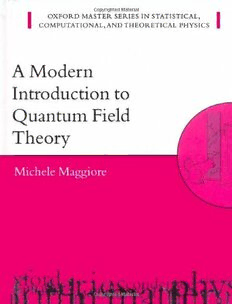Table Of ContentOXFORD MASTER SERIES IN STATISTICAL, COMPUTATIONAL, ANDTHEORETICAL
PHYSICS
OXFORD MASTER SERIES IN PHYSICS
The Oxford Master Series is designed for final year undergraduate and beginning graduate students in physics and
relateddisciplines.Ithasbeendrivenbyaperceivedgapintheliteraturetoday.Whilebasicundergraduatephysicstexts
oftenshowlittleornoconnectionwiththehugeexplosionofresearchoverthelasttwodecades,moreadvancedand
specializedtextstendtoberatherdauntingforstudents.Inthisseries,alltopicsandtheirconsequencesaretreatedata
simplelevel,whilepointerstorecentdevelopmentsareprovidedatvariousstages.Theemphasisinonclearphysical
principleslikesymmetry,quantummechanics,andelectromagnetismwhichunderliethewholeofphysics.Atthesame
time,thesubjectsarerelatedtorealmeasurementsandtotheexperimentaltechniquesanddevicescurrentlyusedby
physicistsinacademeandindustry.Booksinthisseriesarewrittenascoursebooks,andincludeampletutorialmaterial,
examples,illustrations,revisionpoints,andproblemsets.Theycanlikewisebeusedaspreparationforstudentsstarting
adoctorateinphysicsandrelatedfields,orforrecentgraduatesstartingresearchinoneofthesefieldsinindustry.
CONDENSEDMATTERPHYSICS
1.M.T.Dove:Structureanddynamics:anatomicviewofmaterials
2.J.Singleton:Bandtheoryandelectronicpropertiesofsolids
3.A.M.Fox:Opticalpropertiesofsolids
4.S.J.Blundell:Magnetismincondensedmatter
5.J.F.Annett:Superconductivity
6.R.A.L.Jones:Softcondensedmatter
ATOMIC,OPTICAL,ANDLASERPHYSICS
7.C.J.Foot:Atomicphysics
8.G.A.Brooker:Modernclassicaloptics
9.S.M.Hooker,C.E.Webb:Laserphysics
PARTICLEPHYSICS,ASTROPHYSICS,ANDCOSMOLOGY
10.D.H.Perkins:Particleastrophysics
11.Ta-PeiCheng:Relativity,gravitation,andcosmology
STATISTICAL,COMPUTATIONAL,ANDTHEORETICALPHYSICS
12.M.Maggiore:Amodernintroductiontoquantumfieldtheory
13.W.Krauth:Statisticalmechanics:algorithmsandcomputations
14.J.P.Sethna:Entropy,orderparameters,andcomplexity
A Modern Introduction to Quantum
Field Theory
Michele Maggiore
De´partementdePhysiqueThe´orique
Universite´ deGene`ve
1
3
GreatClarendonStreet,OxfordOX26DP
OxfordUniversityPressisadepartmentoftheUniversityofOxford.
ItfurtherstheUniversity’sobjectiveofexcellenceinresearch,scholarship,
andeducationbypublishingworldwidein
Oxford NewYork
Auckland Bangkok BuenosAires CapeTown Chennai
DaresSalaam Delhi HongKong Istanbul Karachi Kolkata
KualaLumpur Madrid Melbourne MexicoCity Mumbai Nairobi
Sa˜oPaulo Shanghai Taipei Tokyo Toronto
OxfordisaregisteredtrademarkofOxfordUniversityPress
intheUKandincertainothercountries
PublishedintheUnitedStates
byOxfordUniversityPressInc.,NewYork
(cid:1)c OxfordUniversityPress2005
Themoralrightsoftheauthorhavebeenasserted
DatabaserightOxfordUniversityPress(maker)
Firstpublished2005
Allrightsreserved.Nopartofthispublicationmaybereproduced,
storedinaretrievalsystem,ortransmitted,inanyformorbyanymeans,
withoutthepriorpermissioninwritingofOxfordUniversityPress,
orasexpresslypermittedbylaw,orundertermsagreedwiththeappropriate
reprographicsrightsorganization.Enquiriesconcerningreproduction
outsidethescopeoftheaboveshouldbesenttotheRightsDepartment,
OxfordUniversityPress,attheaddressabove
Youmustnotcirculatethisbookinanyotherbindingorcover
andyoumustimposethissameconditiononanyacquirer
AcataloguerecordforthistitleisavailablefromtheBritishLibrary
LibraryofCongressCataloginginPublicationData
(Dataavailable)
ISBN0 19 852073 5(Hbk)
ISBN0 19 852074 3(Pbk)
10 9 8 7 6 5 4 3 2 1
PrintedinGreatBritain
onacid-freepaperbyAntonyRowe,Chippenham
A Maura, Sara e Ilaria
This page intentionally left blank
Contents
Preface xi
Notation xii
1 Introduction 1
1.1 Overview 1
1.2 Typical scales in high-energy physics 4
Further reading 11
Exercises 12
2 Lorentz and Poincar´e symmetries in QFT 13
2.1 Lie groups 13
2.2 The Lorentz group 16
2.3 The Lorentz algebra 18
2.4 Tensor representations 20
2.4.1 Decomposition of Lorentz tensors under SO(3) 22
2.5 Spinorial representations 24
2.5.1 Spinors in non-relativistic quantum mechanics 24
2.5.2 Spinors in the relativistic theory 26
2.6 Field representations 29
2.6.1 Scalar fields 29
2.6.2 Weyl fields 31
2.6.3 Dirac fields 32
2.6.4 Majorana fields 33
2.6.5 Vector fields 34
2.7 The Poincar´egroup 34
2.7.1 Representation on fields 35
2.7.2 Representation on one-particle states 36
Summary of chapter 40
Further reading 41
Exercises 41
3 Classical field theory 43
3.1 The action principle 43
3.2 Noether’s theorem 46
3.2.1 The energy–momentum tensor 49
3.3 Scalar fields 51
3.3.1 Real scalar fields; Klein–Gordon equation 51
3.3.2 Complex scalar field; U(1) charge 53
viii Contents
3.4 Spinor fields 54
3.4.1 The Weyl equation; helicity 54
3.4.2 The Dirac equation 56
3.4.3 Chiral symmetry 62
3.4.4 Majorana mass 63
3.5 The electromagnetic field 65
3.5.1 Covariantform of the free Maxwell equations 65
3.5.2 Gauge invariance; radiation and Lorentz gauges 66
3.5.3 The energy–momentum tensor 67
3.5.4 Minimal and non-minimal coupling to matter 69
3.6 First quantization of relativistic wave equations 73
3.7 Solved problems 74
The fine structure of the hydrogen atom 74
Relativistic energy levels in a magnetic field 79
Summary of chapter 80
Exercises 81
4 Quantization of free fields 83
4.1 Scalar fields 83
4.1.1 Real scalar fields. Fock space 83
4.1.2 Complex scalar field; antiparticles 86
4.2 Spin 1/2 fields 88
4.2.1 Dirac field 88
4.2.2 Massless Weyl field 90
4.2.3 C, P, T 91
4.3 Electromagnetic field 96
4.3.1 Quantization in the radiation gauge 96
4.3.2 Covariantquantization 101
Summary of chapter 105
Exercises 106
5 Perturbation theory and Feynman diagrams 109
5.1 The S-matrix 109
5.2 The LSZ reduction formula 111
5.3 Setting up the perturbative expansion 116
5.4 The Feynman propagator 120
5.5 Wick’s theorem and Feynman diagrams 122
5.5.1 A few very explicit computations 123
5.5.2 Loops and divergences 128
5.5.3 Summary of Feynman rules for a scalar field 131
5.5.4 Feynman rules for fermions and gauge bosons 132
5.6 Renormalization 135
5.7 Vacuum energy and the cosmologicalconstant problem 141
5.8 The modern point of view on renormalizability 144
5.9 The running of coupling constants 146
Summary of chapter 152
Further reading 153
Exercises 154
Contents ix
6 Cross-sections and decay rates 155
6.1 Relativistic and non-relativistic normalizations 155
6.2 Decay rates 156
6.3 Cross-sections 158
6.4 Two-body final states 160
6.5 Resonances and the Breit–Wigner distribution 163
6.6 Born approximation and non-relativistic scattering 167
6.7 Solved problems 171
Three-body kinematics and phase space 171
Inelastic scattering of non-relativistic electrons on atoms 173
Summary of chapter 177
Further reading 178
Exercises 178
7 Quantum electrodynamics 180
7.1 The QED Lagrangian 180
7.2 One-loop divergences 183
7.3 Solved problems 186
e+e− →γ →µ+µ− 186
Electromagnetic form factors 188
Summary of chapter 193
Further reading 193
Exercises 193
8 The low-energy limit of the electroweak theory 195
8.1 A four-fermion model 195
8.2 Charged and neutral currents in the Standard Model 197
8.3 Solved problems: weak decays 202
µ− →e−ν¯ ν 202
e µ
π+ →l+ν 205
l
Isospin and flavor SU(3) 209
K0 →π−l+ν 212
l
Summary of chapter 216
Further reading 217
Exercises 217
9 Path integral quantization 219
9.1 Path integral formulation of quantum mechanics 220
9.2 Path integral quantization of scalar fields 224
9.3 Perturbative evaluation of the path integral 225
9.4 Euclidean formulation 228
9.5 QFT and critical phenomena 231
9.6 QFT at finite temperature 238
9.7 Solved problems 239
Instantons and tunneling 239
Summary of chapter 241
Further reading 242
x Contents
10 Non-abelian gauge theories 243
10.1 Non-abelian gauge transformations 243
10.2 Yang–Mills theory 246
10.3 QCD 248
10.4 Fields in the adjoint representation 250
Summary of chapter 252
Further reading 252
11 Spontaneous symmetry breaking 253
11.1 Degenerate vacua in QM and QFT 253
11.2 SSB of global symmetries and Goldstone bosons 256
11.3 Abelian gauge theories: SSB and superconductivity 259
11.4 Non-abelian gauge theories: the masses of W± and Z0 262
Summary of chapter 264
Further reading 265
12 Solutions to exercises 266
12.1 Chapter 1 266
12.2 Chapter 2 267
12.3 Chapter 3 270
12.4 Chapter 4 272
12.5 Chapter 5 275
12.6 Chapter 6 276
12.7 Chapter 7 279
12.8 Chapter 8 281
Bibliography 285
Index 287

